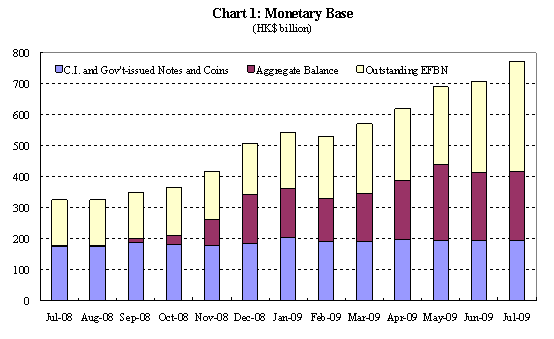Inflows of funds into the Hong Kong dollar could have implications for monetary stability: there are ways to address them.
Readers may be aware of persistent inflows into the Hong Kong dollar in recent months. Such inflows could have implications for monetary stability in Hong Kong if they persist, or if they were to suddenly go into reverse. The Currency Board Sub-Committee of the Exchange Fund Advisory Committee has recently examined these implications and the policy measures available to address them.
Inflows into the Hong Kong dollar have been considerable in recent months, leading to repeated triggering of the strong-side Convertibility Undertaking. As a result, the Monetary Base expanded to HK$771 billion at the end of July 2009 from HK$324 billion a year ago. Chart 1 shows the movements in the Monetary Base over time, with changes in its components – notes and coins in circulation, the Aggregate Balance, and the outstanding amount of Exchange Fund paper. An increase in the Monetary Base represents capital inflows. While notes and coins in circulation have been relatively steady, capital inflows have led to repeated triggering of the strong-side Convertibility Undertaking and a subsequent increase in the Aggregate Balance, moderated by the issuance of additional Exchange Fund Bills.
Judging by information from our market contacts, these inflows were largely "real money" — that is, not related to any speculative activity in the currency — from investors attracted by the opportunities here and looking to position themselves to benefit from the strong outlook for the Mainland and Hong Kong economies. At the same time, the usual interest in selling Hong Kong dollars and buying US dollars diminished in the absence of a significant differential between local and US interest rates. The exchange rate has thus stayed near the strong-side Convertibility Undertaking level of 7.7500.
In the past few months we have issued more Exchange Fund Bills to meet banks' demand for the paper for liquidity management and the Aggregate Balance has declined correspondingly. This is consistent with Currency Board principles since it simply represents a shift between two components of the Monetary Base, from the Aggregate Balance to the stock of Exchange Fund Bills and Notes, without affecting the size of the Monetary Base. If the Aggregate Balance continues to expand, there will be room to issue more Exchange Fund Bills, the demand for which has remained keen as shown by the low yields on the Bills and the over-subscription of issues. Banks tend to prefer parking their surplus liquidity in Exchange Fund Bills, albeit at a low yield, rather than the non-interest-bearing clearing account. The timing and amount of further issuance will be determined in response to market demand, and is unlikely to have a significant impact on monetary conditions.
There are two possible implications of these strong inflows into the Hong Kong dollar. First, if they continue, they may lead to inflation in asset and consumer prices, which, if it persisted, could pose a threat to macroeconomic and financial stability. Secondly, there is a risk of a sudden reversal of the flows, which would end the current loose monetary environment.
While we do not see any signs yet of excessive credit creation, which might fuel speculation in asset markets, we are mindful of the potential negative impact that asset-price bubbles, if they were to occur, could have on financial stability and especially the stability of the banking system. Under the Currency Board arrangements, there is little room to use monetary tools to contain inflationary pressure since monetary conditions in Hong Kong are determined by interest rates in the US and by capital flows. But we would be able to use prudential and supervisory measures to ensure that banks did not expand their lending to asset markets imprudently. This would help restrain credit expansion arising from strong capital inflows, and banks’ credit-risk exposure, which might increase sharply if an asset-price bubble were to burst.
We are equally alert to the possibility of a reversal of capital flows, which might be triggered if economic outturns and corporate earnings were to disappoint; by a rise in US interest rates; or, more positively, by an improvement in investment opportunities abroad. Under the Currency Board arrangements, the increased foreign reserves built up during the inflows and the automatic interest-rate adjustment resulting from any reversal would act as a cushion against downward pressure on the exchange rate. It would be difficult to judge in advance the timing and size of any outflows, but it would be desirable for the adjustment in monetary conditions to be orderly. With the strengthening of the Currency Board arrangements over the years and particularly with the introduction of the three refinements in 2005, we are better equipped to support an orderly adjustment in monetary conditions and maintain exchange-rate stability. Where appropriate, operations within the Convertibility Zone may be conducted to avoid destabilising movements in the exchange rate and interest rates.
Joseph Yam
6 August 2009

Click here for previous articles in this column.
Document in Word format


